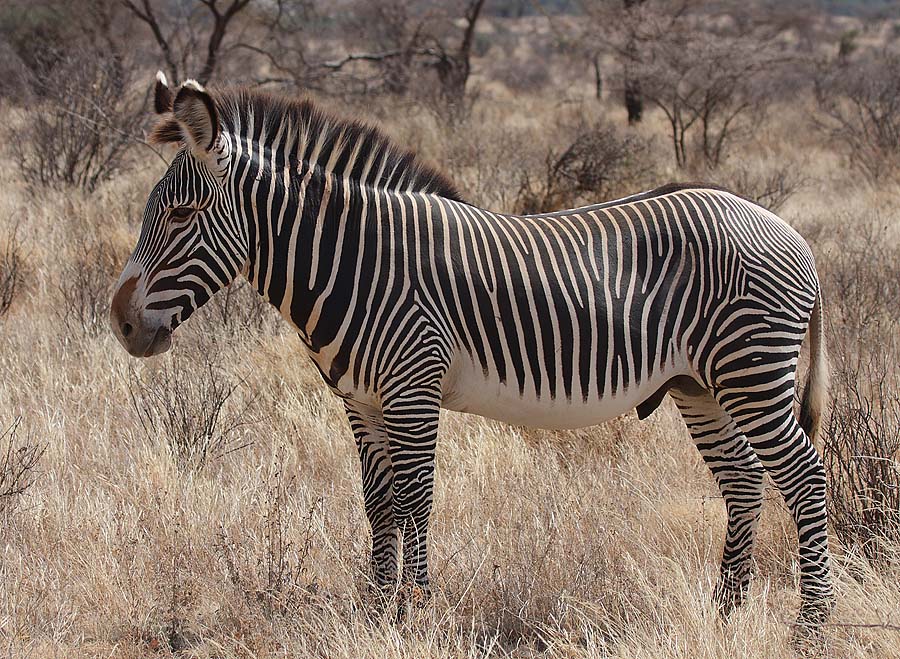Grévy's Zebra
| Grévy's Zebra | |||
|---|---|---|---|
| グレビーシマウマ | |||
| Character Data | |||
| Romaji | Gurebīshimauma
| ||
| Debut | Kemono Friends (2015 Game) | ||
| Animal Data | |||
| Scientific Name | Equus grevyi
| ||
| Distribution | Kenya and Ethiopia
| ||
| Diet | Herbivore
| ||
| Avg. Lifespan | 20 years
| ||
| Read More | Grévy's zebra
| ||
| Conservation | 
| ||
| Grévy's Zebra | Festival | Nexon Game | Gallery |
The Grévy's Zebra is a type of Zebra Friend that appeared in the original Kemono Friends mobile game.
Appearance
Grévy's Zebra's long hair has a black and white striping pattern and an ahoge on the top. Her reaches at least below the shoulder blades with part of it cut to about shoulder-length and a fringe that reaches the eyebrows. Her outfit is almost entirely striped, except for her sleeveless white western shirt, which has a yellow tie. Her consists of a top buried inside her western shirt, a ripped jean shorts, tights and a pair of boots. incidentally, she carries dowsing L-roots. As most of the other friends, She bears the tail and the ears of the animal she's based on.
On an outfit level, Grévy's Zebra's new design wears the same kind of clothes as the old one. Only this time she has a blue western shirt widely open on chest level, high tights and common shoes. Her dowsing L-roots have been replaced by a dowsing pendulum which is made of a Japanese five yen, but on top of that, she's bearing a water bottle pouch on each legs on which appear a french flag, and a portable steel water bottle on her right side. On a details level, her stripes are much more faithful to the actual Grévy's Zebra, just like her ears and her tail.
Series Appearances
| Media | Role | |
|---|---|---|
In Real Life

.
The Grévy's zebra (Equus grevyi), also known as the imperial zebra, is the largest living wild equid and the largest and most threatened of the three species of zebra, the other two being the plains zebra and the mountain zebra. Grevy’s Zebras live in arid and semi-arid grass/shrubland where they can gain access to permanent water. [1]
They are predominantly grazers, although browse can comprise up to 30% of their diet during times of drought or in those areas that have been highly transformed through overgrazing. They are extremely mobile and individuals have been recorded to move distances of greater than 80 km, with movements determined by the availability of resources. Most Grevy's zebras can survive without water for up to five days, but lactating females must drink at least every other day in order to maintain healthy milk production. During the dry season, when they are dependent on permanent water, Grevy’s Zebra may stay nearer to water and tend to be more concentrated. [2] [3]
Grevy's zebras are different from most other members of the genus Equus in that they do not have concrete social structure. They are loosely social animals, herd composition can vary on a daily basis as new members enter a dominant male's territory and old members leave. The two most stable relationships that Grevy's zebras have are a stallion's attachment to his territory and a mare's attachment to her young. There is not a rigorously observed hierarchy of dominance within a group of Grevy's zebras, although a dominance structure is present. Several theories exist as to the function of the stripes of Grevy’s zebra, from camouflage to the dazzling of predators. Recent research has suggested, however, that they may serve a social function and may stimulate grooming. [4] [5]
Habitat loss presents a major threat to the long-term survival of the species as grasslands and water sources have significantly declined due to unplanned grazing by livestock. In addition, there has been a significant, very recent decline in the species in northern Kenya due to disease and drought. Over the last ten years, conservation efforts centred on Grevy’s zebra have significantly increased. In northern Kenya, there are a growing number of community conservancies in key Grevy’s zebra range now managing their land for wildlife conservation. [6] [7]
Trivia
- Grevy's Zebra is named after Jules Grévy, the first real republican President of France.
References
- Alexis J. Hollingshead. "Equus grevyi". Animal diversity Web. University of Michigan, museum of zoology.
- Grevy's zebra, Arkive.
- Moehlman, P.D.; Rubenstein, D.I. & Kebede, F. (2008). "Equus grevyi". IUCN Red List of Threatened Species.
- Grevy's Zebra Trust – a Kenyan organization dedicated to preserving the Grévy's zebra.
- ↑ Moehlman, P.D.; Rubenstein, D.I. & Kebede, F. (2008). "Equus grevyi". IUCN Red List of Threatened Species.
- ↑ Alexis J. Hollingshead. "Equus grevyi". Animal diversity Web. University of Michigan, museum of zoology.
- ↑ Moehlman, P.D.; Rubenstein, D.I. & Kebede, F. (2008). "Equus grevyi". IUCN Red List of Threatened Species.
- ↑ Grevy's zebra, Arkive.
- ↑ Moehlman, P.D.; Rubenstein, D.I. & Kebede, F. (2008). "Equus grevyi". IUCN Red List of Threatened Species.
- ↑ Grevy's zebra, Arkive.
- ↑ Grevy's Zebra Trust – a Kenyan organization dedicated to preserving the Grévy's zebra.

